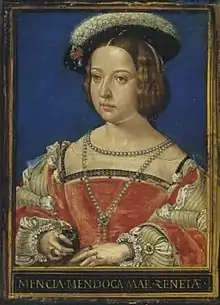
Mencía de Mendoza y Fonseca (30 November 1508 - 4 January 1554) was a Dutch culture patron. She was a leading figure of the Renaissance in the Netherlands and known for her progressive opinions of the education of women.
Life
Mencía was the daughter of Rodrigo Díaz de Vivar y Mendoza, 1st Marquis of Cenete and María de Fonseca y Toledo. She married firstly Henry III of Nassau-Breda in 1524,[1] a marriage which encouraged by the reigning monarch, Charles V, who was actively working on a plan to make the nobility of Spain and the Low Countries mix. Together, they ultimately had one son who was born in March 1527, and would only live a few hours after his birth. Her second marriage was to Ferdinand, Duke of Calabria in 1542.[2] The marriage was Mencía's second, and Ferdinand's third. The couple became renowned for their patronage in literary and artistic works.
References
- ↑ Spivakovsky 1970, p. 9.
- ↑ Perez-Toribio 2011, p. 74.
Sources
- Perez-Toribio, Montserrat (2011). "From Mother to Daughter: Educational lineage in the Correspondence between the Countess Palamos and Estafania de Requensen". In Cruz, Anne J.; Hernández, Rosilie (eds.). Women's Literacy in Early Modern Spain and the New World. Ashgate.
- Spivakovsky, Erika (1970). Son of the Alhambra: Don Diego Hurtado de Mendoza, 1504-1575. University of Texas Press.
External links
- Matty Klatter, Mendoza y Fonseca, Mencía de, in: Digitaal Vrouwenlexicon van Nederland. URL: http://resources.huygens.knaw.nl/vrouwenlexicon/lemmata/data/MenciadeMendoza [13/01/2014]